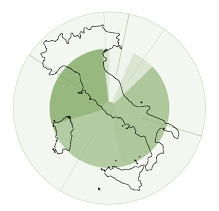By 2050, it is estimated that antimicrobial resistance (AMR) will cause 10 million annual deaths worldwide, costing up to $100 trillion. Antibiotic resistance (ABR) is the most significant health threat and, in 2019, caused 1.27 million deaths globally. One in 5 deaths occurred under five years of age, and 6 bacterial pathogens accounted for more than 70% of deaths.
Our objective was to compare mortality and disability estimates (DALYs) associated with ABR in 2019 in Italy and Western Europe (WE), classifying the infectious syndromes and bacterial pathogens involved, in order to identify the most urgent public health needs in Italy.
Estimates of the burden of ABR in 2019 in EO and Italy, extracted from the Measuring Infectious Causes and Resistance Outcomes for Burden Estimation (MICROBE) tool of the Institute for Health Metrics and Evaluation (IHME; Seattle, USA), covered deaths and DALYs associated with 33 pathogens and 12 infectious syndromes, as well as deaths and DALYs associated with and attributable to ABR. Among the 12 infectious syndromes in the 2019 Global Burden of Disease Study, those with the greatest impact in terms of mortality rates and DALYs per 100,000 population were selected, and the relative burden associated with ABR was reported for each. Next, the comparison looked at the burden of major pathogens (bacteria, viruses, fungi and polymicrobial infections) for all infectious syndromes. For each bacterium, the mortality rates and DALYs associated with ABR and the percentage of burden attributable to it were reported. Although it is well known that Italy is one of the EO countries with the largest share of elderly people, raw rather than age-standardized rates were used in the comparison in order to quantify the true burden of ABR in the two areas.
In the two areas, the largest difference in ABR-associated mortality was found for blood (25.2 and 18.8 per 100,000 in Italy and EO, respectively), peritoneal and abdominal infections (15.1 and 12.2 in Italy and EO, respectively). However, the rates of deaths and DALYs attributable to ABR were higher in Italy for all infectious syndromes considered. In both areas, Escherichia coli is responsible for the highest burden associated with ABR, both for deaths and DALYs. The highest percentage of mortality attributable to resistance, however, emerged for Acinetobacter baumannii (28.4 percent in EO and 31.9 percent in Italy), which is also responsible for the highest percentage of DALYs attributable to ABR (28.4 percent in EO and 31.7 percent in Italy). The pathogen-drug pair with the highest AMR-associated burden is Escherichia coli-Aminopenicillin, while the Staphylococcus aureus-Methicillin (MRSA) pair is responsible for the highest burden attributable to AMR. The average percentage of Aminopenicillin-resistant Escherichia coli in EO was 55.4 percent, with Italy ranking third (67.6 percent). Northern countries showed lower percentages, with the lowest value in Sweden (32.8 percent). On average, an MRSA rate of 16 percent was found in EO, exceeded by more than 13 points by Italy.
Although sepsis mortality rates are broadly similar in Italy and other EO countries, a higher proportion of deaths associated with and attributable to ABR emerged in Italy. Strategies aimed at reducing the circulation of resistant bacteria and microorganisms, along with other interventions, are essential to achieve a decrease in ABR-associated deaths.
- Zamagni G, Forni S, Iavicoli I, Guicciardi S, Buonsenso D, Ferrara P, De Luca M, Golinelli D, Sanmarchi F, Collatuzzo G, Gemmi F, Naghavi M, Sabbatucci M, Monasta L. Estimates of antibiotic resistance in Italy and Western Europe in 2019: a comparative analysis based on MICROBE. Epidemiol Prev. 2024 Jan-Feb;48(1):48-59. DOI: 19191/EP24.1.A648.020
